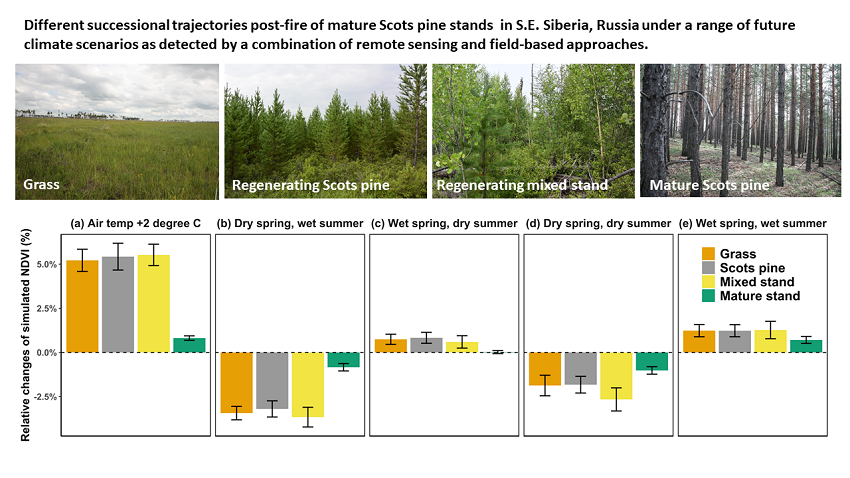Climate variability may delay post-fire recovery of boreal forest in southern Siberia, Russia.

Prolonged dry periods and increased temperatures that result from anthropogenic climate change have been shown to increase the frequency and severity of wildfires in the boreal region. There is growing evidence that such changes in fire regime can reduce forest resilience and drive shifts in post-fire plant successional trajectories.
This study, led by Dr Bob Baxter with a team of researchers investigated the responses of post-fire recruited species to climate change and inter-annual variability at 16 study sites that experienced high severity fire events, mostly in early 2000, within the Scots pine forest – steppe zone of south-eastern Siberia, Russia. It employed a combination of field-based and satellite remote sensing protocols.
A Bayesian Additive Regression Trees (BART) approach was used to model the relationship between Landsat-derived Normalized Difference Vegetation Index (NDVI) time series, temperature and precipitation in the 15 years after a stand replacing fire. Using the resulting BART models, together with six projected climate scenarios with increased temperature and enhanced inner-annual precipitation variability, we simulated NDVI at five-year intervals for 15 years post-fire.
Increased temperature enhanced greenness across all sites and across all three time periods since fire, exhibiting a positive feedback in a warming environment. Repeatedly dry spring periods reduced NDVI at all the sites and wetter summer periods following such dry springs could not compensate for this, indicating that a prolonged dry spring has a strong impact consistently over the entire early developmental stages from the initial five years to 15 years post-fire.
Young forests showed higher climate sensitivity compared to the mature forest, irrespective of species and projected climatic conditions. Our findings suggest that a dry spring not only increases fire risk, but also delays recovery of boreal forests in southern Siberia. It also highlights the importance of changing rainfall seasonality as well as total rainfall in a changing climate for post-fire recovery of forest.
Further Information:
Read the research paper in Remote Sensing https://www.mdpi.com/2072-4292/13/12/2247
Find out about the Department of Biosciences at Durham University
Visit Dr Bob Baxter's staff page at Durham University


/prod01/prodbucket01/media/durham-university/departments-/biosciences/infrastructure-/12475.jpg)
/prod01/prodbucket01/media/durham-university/departments-/biosciences/12030.jpg)
/prod01/prodbucket01/media/durham-university/departments-/biosciences/infrastructure-/Crop-greenhouse.jpg)
/prod01/prodbucket01/media/durham-university/departments-/biosciences/infrastructure-/12479.jpg)